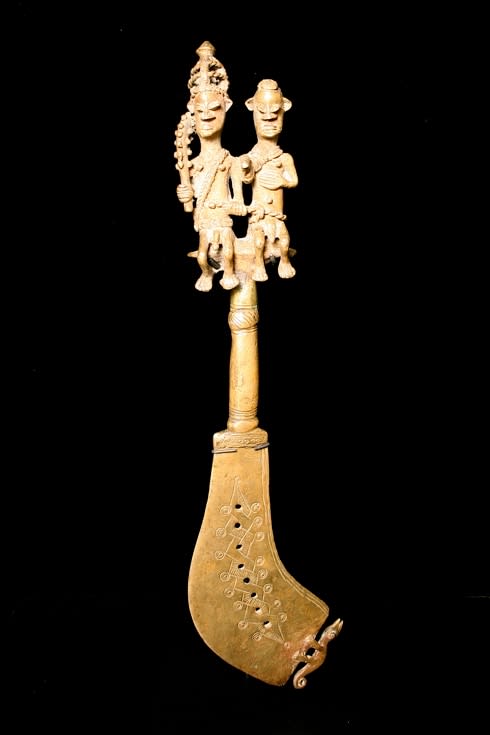Yoruba Ceremonial Brass Sword, 20th Century CE
Brass
18
PF.6114
The dull blade of this sword, perforated with a slightly arching series of eight holes, reveals that it was not a weapon, but a ceremonial symbol of rank and authority....
The dull blade of this sword, perforated with a slightly arching series of eight holes, reveals that it was not a weapon, but a ceremonial symbol of rank and authority. Staffs have long been regarded as the demarcation of rulership in various cultures across the globe. Certainly, this sword, which functions more as a staff, is no exception. The inherent value of the material alone implies wealth while the artistry of the work comments on the owners refined tastes and aesthetic appreciation. The top of the hilt is decorated with a seated pair of male figures. In Africa, stools are regarded as the penultimate symbol of authority. Thus, the figures, represented seated, are immediately associated with the ruling elite. In fact, this couple may represent a king and his slave. The figure on the left wears a towering openwork headdress and carries an embossed, curved club, both characteristic royal regalia. Just as the club identifies the figure as royalty or a tribal ruler, so too this staff would have marked its original owner as a member of the Yoruba elite. However, the figure to his right wears a knotted rope harness around his waist that the kingly figure holds onto. Furthermore, the right arm of the slave appears to be bound to his neck, severely limiting his powers of mobility. While this pair might depict a ruler and his servant, there may be another explanation grounded in Yoruba mythological or proverbial traditions that is foreign to our comprehension. A chameleon represented hanging onto the end of the blade might hint at the mythological subtext of the work. However, chameleons are also associated with the ruling elite for their ability to alter their appearance to suit the environment. Clearly, this sword is much more than a symbol of power; it is a striking work of art rich in its cultural context.
